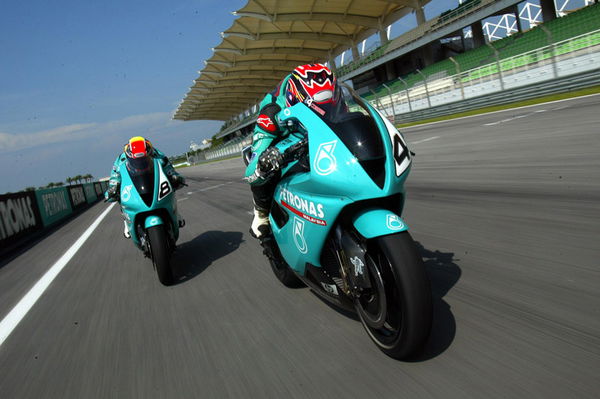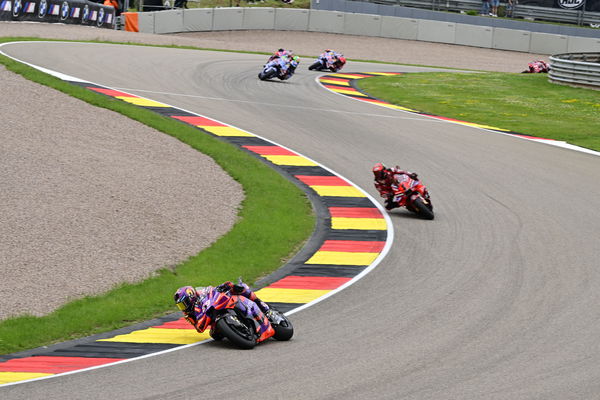Foggy's Little Wonder: The Petronas FP1 Story
Clean-sheet design to front-row start in the WSB opener in 16 months? Here's how...


Just sixteen months between signing on the dotted line with Petronas and Troy Corser lining up on the grid in fourth place on the grid for the first round of the 2003 World Superbike race at Valencia.
James Haydon scored points in the first ever race for the new bike in 12th position, while in race two, Troy Corser took 7th.
Think about that for a moment.
A few paddock doubters were probably hoping for poor results. After all, when the original deadline for the Foggy Petronas FP1 to go racing at the 2002 round at Laguna Seca in the US was missed, and then postponed indefinitely, you could almost hear the said knockers rubbing their hands in glee. Carl had failed, he'd screwed up, they said.
But others who'd witnessed his determination on track, as well as seeing the quality of the team he was building around him, could see that betting against Carl was likely to be a mug's game.
"We were never going racing last year, to be honest. We didn't like letting people down for sure," says Carl, "but we had to set such short deadlines so that we would all aim for something and get the maximum done in the time available. To be honest, despite the extra time we had, we could still have done with an extra month before that first race."
And what a lot to do.
At the beginning, the nucleus of the team spent most of their time around a table sifting through designs for the bike, transporters, and hospitality units, interviewing riders. If you've seen the 'Against All Odds' programme on Men and Motors or DVD you'll know what I mean. The first hour or so isn't rivetting watching, as you see co-owners Foggy, Michaela Fogarty, team-manager Nigel Bosworth, Chief Executive Murray Treece and Marketing and PR boss Neil Bramwell discussing subjects like what the colour of the hospitality shag-pile should be, while they sit in all the opulence of a conference room in a Manchester Travel Inn. Despite the lure of bottomless coffee cups and free Bourbons, amazingly they got it all done.
To build a race-bike in such a stringent time-frame was tough, but to do that while building the team to run these bikes, finding premises for the team to operate out of, organising the selection and construction of team transporters etc must had been rock hard.
Add into the mix the secondary but vitally important ancillaries such as hiring riders for a team no-one had heard of and with bikes that weren't built and it's amazing they got anything done at all.
They built a team around them which is very compact (only about '17-18 strong', according to chief exec Treece) and then promptly setting about doing the business. Within nine weeks they'd moved into and furnished their premises in Burton. Impressive isn't the word when you visit the place. As well as all the corporate bells and whistles you'd expect with a team HQ that has to accommodate suits as well as team-shirts and overalls, FPR has built a state-of-the-art dyno room. Inside is a Superflow dyno, fitted with an Eddy-Current load cell that allows the team to simulate real life conditions such as wind loadings, circuit inclines and tyre friction through the data-acquisition system. Rob Mathewson (he once of RMD Dynos) is the man who gets to play with it. And yes, it did cost. It cost plenty but, as Foggy himself says: "It's not an open cheque book. We have budgets we have to stick to, although we are a works team."
Budgets. Important. Money comes from Malaysian oil giants Petronas, who signed a five-year deal with Foggy to go racing in WSB and - just as importantly - build a rockin' road bike, Malaysia's first. Be proud, though, as it stems from Britain. By February and March of 2002, the team and Piper Designs had made the mock-up clay model and plonked it in the wind tunnel for testing.
But why a triple? Well, it's a throwback to Petronas' original thought of going GP racing, but that's not all.
Foggy says: "Experts at Queens University in Belfast and have run the whole simulation thing through computers and it came out that the three-cylinder configuration is the best compromise for the motor, it's just that no-one has made it successful yet. We're at the start of development. We know where to get more horsepower and torque from the motor. We were very happy during testing that nothing major went wrong. The motor has changed a bit since the GP-1 bike that it was intended for, but it's nice to do something different from what else is out there, like a twin. I'm not sure if the bike and it's power characteristics will be particularly suited to any tracks, maybe places where mid-corner speed is essential, like Donington Park. Shame we don't race there."











